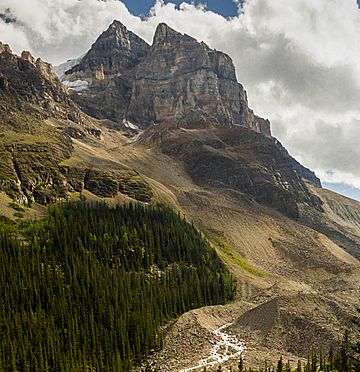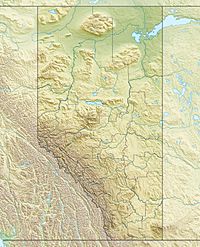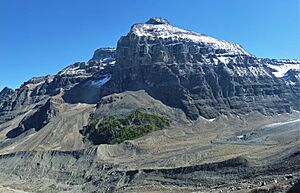Mount Aberdeen (Alberta) facts for kids
Quick facts for kids Mount Aberdeen |
|
|---|---|

Mount Aberdeen as seen from the Plain of the Six Glaciers trail
|
|
| Highest point | |
| Elevation | 3,157 m (10,358 ft) |
| Prominence | 566 m (1,857 ft) |
| Parent peak | Mount Lefroy (3442 m) |
| Listing | Mountains of Alberta |
| Geography | |
| Location | Alberta, Canada |
| Parent range | Bow Range |
| Topo map | NTS 82N/08 |
| Geology | |
| Age of rock | Cambrian |
| Type of rock | Sedimentary rock |
| Climbing | |
| First ascent | 1894 Samuel E.S. Allen, L.F. Frissel, Walter D. Wilcox |
Mount Aberdeen is a tall mountain in Banff National Park, Alberta, Canada. It stands 3,157-metre (10,358-foot) high. This impressive mountain is found near the famous Lake Louise area.
Mount Aberdeen is part of the Canadian Rockies. Its closest higher neighbor is Mount Lefroy, which is about 2.9 km (1.8 mi) away. Haddo Peak is also nearby, sharing the same large mountain mass. A glacier called the Aberdeen Glacier lies between Mount Aberdeen and Haddo Peak.
Contents
Mountain History and Naming
How Mount Aberdeen Got Its Name
Mount Aberdeen was officially named in 1897. James J. McArthur gave it this name. He chose it to honor Lord Aberdeen. Lord Aberdeen was an important person in Canada's history. He served as the 7th Governor General of Canada. A Governor General is like the King or Queen's representative in a country.
Before 1897, the mountain had a different name: Hazel Peak. However, no one knows for sure who "Hazel" was. The name Mount Aberdeen became official in 1952. This was decided by the Geographical Names Board of Canada.
First Climbs to the Summit
The first time anyone successfully climbed Mount Aberdeen was in 1894. A team of three climbers made this first ascent. They were Samuel E.S. Allen, L.F. Frissel, and Walter D. Wilcox.
Later, in 1917, another climber named V.A. Flynn reached the top. He did this by first climbing Haddo Peak. Then, he carefully descended to the Aberdeen Glacier. From there, he climbed up steep snow and an icy ridge to reach Mount Aberdeen's summit.
Mountain Geology
Understanding the Rocks of Mount Aberdeen
Like other mountains in Banff National Park, Mount Aberdeen is made of sedimentary rock. This type of rock forms over a very long time. It is made from layers of sand, mud, and tiny bits of sea creatures. These layers settle at the bottom of ancient seas.
The rocks of Mount Aberdeen were formed during huge spans of time. These periods are known as the Precambrian and Jurassic eras. During the Laramide orogeny, a major mountain-building event, these rocks were pushed up. They moved east and slid over younger rock layers. This process created the tall peaks we see today.
Mountain Climate
Weather at Mount Aberdeen
Mount Aberdeen is located in a subarctic climate zone. This means the mountain experiences very cold winters. It also gets a lot of snow. The summers are usually mild, not too hot.
Temperatures on the mountain can drop very low. It can get colder than −20 °C (which is about -4 °F). When the wind blows, it can feel even colder. This is called the wind chill factor. The wind chill can make it feel like −30 °C (-22 °F) or even colder.




